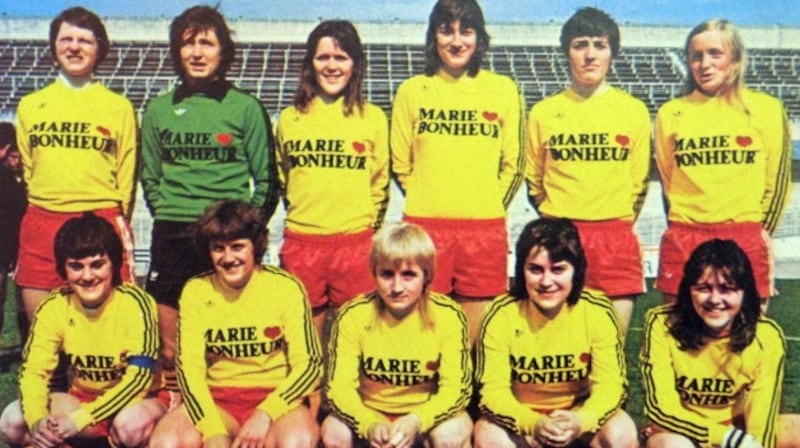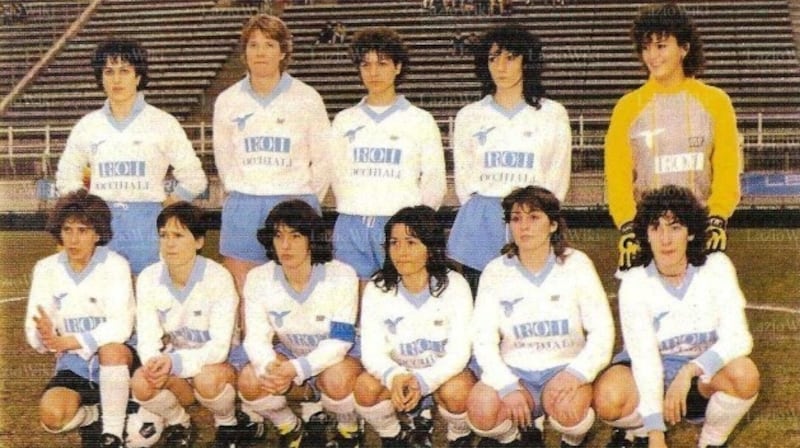No Irish player in history comes close to Anne O'Brien's achievements, with her haul of nine league titles with Stade de Reims in France and Lazio in Italy surpassing all in the professional game.
O'Brien is an inspiration to Ireland's modern-day stars and the young girls hoping to follow in their footsteps. It is with no small dose of irony that, while her Republic of Ireland career spanned just a smattering of caps, no player in the near fifty-year history of the national team has since come close to achieving the global recognition that O'Brien continues to hold among those who saw or worked alongside her.
Growing up in an age in Ireland during which there were very unyielding perceptions over how young women should live their lives, she was a football-mad girl who would while away hours kicking a ball around on the streets of Inchicore. The only girl among hordes of young boys, she was an outlier then and would remain so across an illustrious career.
O'Brien, a cousin of Irish football greats Johnny Giles and Jimmy Conway (third and first, respectively), came to the attention of Stade de Reims when the French side embarked on a tour of Ireland in August 1973. Part of a Dublin selection playing a friendly in Dundalk, she caught the eye of manager Pierre Geoffroy, and was subsequently asked whether she would consider joining the visitors on the next leg of their Irish tour, in Limerick, as the team were short players due to injury.
O’Brien ultimately accepted the offer and, with her parents’ say-so, to travel over to France for a trial of sorts with the club. In December, the 17-year-old played in three friendlies for Reims, where she impressed once again. Still weeks away from turning 18, a deal was agreed to join the club in advance of the 1974 campaign.
Close control
An RTÉ news report, conducted by reporter Tom McCaughren and broadcast on Monday, 24 January 1974, showed O'Brien playing on the street outside her home on Oblate Drive in Inchicore.
There was plenty of space to play on the streets back then, when neither side of the road was obstructed with parked cars - though the player’s renowned close control suggests she would have been just as at home honing her skills on more confined modern-day streets too. When asked by the reporter whether she expected a long career in the game, she replied, ‘I hope so.’
While the full extent of O’Brien’s achievements have only been given widespread exposure in Ireland more recently, her move did make headlines at the time, though more for the novelty of it than anything else. The news also made headlines in France, via ITN in London.
She had become the first female player, Irish or British, to play the professional game. Known for her balance, vision and cultured left foot, O’Brien quickly became central to Reims’ play, and acted as the team’s main source of goals. She helped them to three successive league titles, as well as a cup win in which she hit a hat-trick in the final. A star had been born.

However, just as Stade de Reims had acquired O’Brien on a tour, they lost her to a bigger team when they embarked on an end-of-season tour to Italy in 1976. Lazio’s offer of superior terms and the chance to play in Italy proved too good to turn down.
In Italy, she helped Lazio win the Coppa Italia in her debut season before they claimed a first league title in 1979. They repeated the trick a year later, with O’Brien the key player in the coveted number 10 shirt.
Her time at Lazio was split up by a season with Trani, a small club on the Adriatic coast, which she helped lead to their first league title in 1984. All this meant that in her 10 years since leaving Dublin, and still only 28, O'Brien was toasting her sixth league title in the professional game.
Back in Dublin, news of her achievements were largely lost amidst the travails of the men’s senior international football team, the League of Ireland and the popularity of cross-channel English football.
Her involvement with the national team would undoubtedly have provided a boon on the pitch and off for a team in its infancy. The Women's Football Association of Ireland was at the time a separate entity from the organisation that governed the men's game, and there was little in the way of resources to fly O'Brien in for international camps. She won only four caps for the national team, and just one of those came after her move to the continent in 1973.
That was in 1990, when, back in Ireland anyway, she linked up with Fran Rooney's team for a Euro qualifier against the Netherlands at Dalymount Park, a team that included the future Irish manager, Vera Pauw.
O’Brien stated later in life that the Irish association never approached her with a view to coming home for games. While it was supposed that it was unfeasible to bring back Ireland’s best player for international competition, her family - including her mother Rose and her seven siblings - regularly made the trip to Rome and elsewhere to see her.
Back in Italy, the diminutive playmaker’s star never waned. She helped Reggiana to back-to-back league titles before moving to Milan and winning her sixth and final Serie A title in 1992, aged 36.

Street-smarts
Looking back, O’Brien’s learnings from childhood, where she developed her skills playing against boys on the roads around her home, provided her with the street-smarts to not merely survive but thrive in Italian football - a place where the defenders were seen to be as cynical and physically imposing as their famed male counterparts.
She remains closely associated with the Italian striker Carolina Morace, whom she played with at Lazio, Reggiana and Milan. The Italian legend first encountered O'Brien when the Irishwoman was 22 and Morace was just 14 and playing for Belluno. Speaking to The42.ie, Morace recalled their first meeting in 1978. "She was an amazing player. She was smart, she had class but she was dynamic too and she'd never stop running because it came so easily to her. That night in Rome, she came up to me during the match. I was just 14 but in a Roman accent she said to me, 'A regazzi sei proprio brava! - Young girl, you are very good!' She was absolutely one of the best players in the world. But, at that time, there was no TV or social media to celebrate her."
O’Brien’s commitment to the game was absolute. For example, while still playing at the highest level, Anne gave birth to a son, Andrea, but according to her brother Tony, the pregnancy only kept her out of the game for a minimal amount of time. “She was back playing straight away,” he remembers. “I’m sure it was four weeks later that she was back playing for the team again. And she used to breastfeed Andrea in the dressing room.”
O’Brien remained in Italy until her death in August 2016, after a short illness. She was just 60 years of age.
It is one of the most remarkable aberrations in Irish football history that a player widely considered to be the finest of her generation amassed just four international caps across a 20-year career. For years, she had been Ireland’s only female professional player.
To this day, she remains one of only two Irish players to ever win a top-flight league title in France or Italy, the other being Liam Brady. He won two Scudetti with Juventus, but this pales in comparison.
It’s never too late to admire her achievements, nor to push to cement her legacy in Irish sporting history. After all, O’Brien’s career was the perfect example of taking an implausible dream and using it to create an incredible reality.
This edited extract is taken from Emerald Exiles - How the Irish made their mark on World Football by Barry Landy, published by New Island Books












